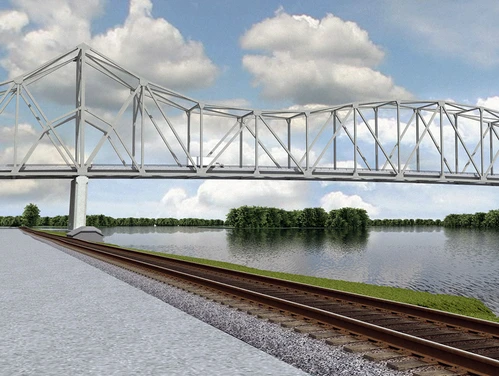On this page...
Project Live Stream
Back to topLansing Bridge Project Overview

Over the next few years, if you’re traveling in the area around Lansing, Iowa, and rural Crawford County, Wisconsin, you’ll see some exciting things happening with the construction of a new Mississippi River Bridge crossing connecting the two areas.
The more than 1,700-foot Mississippi River Bridge connecting Iowa Highway 9 in Lansing, Iowa to Wisconsin Highway 82 in rural Crawford County, Wisconsin stands as an icon for the region. You may have heard of this impressive cantilever bridge referred to as the Black Hawk Bridge. The structure has served the area since 1931 with a closure from 1945 to 1957 when it was damaged by ice dams. Depreciation over time and changing vehicle size and traffic patterns now call for a new, wider, safer crossing.
Working with you through public meetings and other outreach efforts, we’re proud to get started on a safe, functional, and beautiful bridge that will serve the area for generations. What we heard loud and clear is how iconic this structure is to the region. We don’t take that lightly and have done everything we can to mimic the things you love about the current bridge in the new one.
Back to topWhy does the current bridge need to be replaced?
A lot of data has been collected related to the current structure. Here are just a few conclusions from the analysis of this data:
- Structural condition – The current bridge rates as low for its structure. This limits commercial traffic and is impacting freight movement in the region.
- Geometry – The tight turn where Iowa 9 intersects in Lansing makes it difficult for truck traffic, also impacting freight movement in the region.
- Safety - The deck is narrow at only 21 feet and has no shoulders. This gives no room for motorists with mechanical trouble to pull over safely. Any crash or other incident will likely close the bridge completely.
- Ride - The old bridge had a steel grate deck that provides a very rough ride. The steel grates were difficult for our winter maintenance crews to remove snow and ice.
- Navigation - The 650-foot width of the navigation channel is problematic for barges.
What can you expect from the new bridge?
In addition to collecting a lot of data about the current bridge, we’ve listened to you at several public hearings. You told us what is important to you about the old bridge and what you expect with the new one.
- Design – The existing bridge is a beloved structure in the region. The new bridge was thoughtfully designed and has a similar look of the existing bridge.
- Geometry – The Iowa 9 intersection in Lansing will be upgraded to allow for safer truck travel.
- Safety - The new bridge will have wider lanes and eight-foot-wide shoulders (40 feet total), greatly increasing safety.
- Ride - The new bridge will have a smooth, concrete deck that will protect the superstructure from winter maintenance treatments.
- Navigation – The navigation channel will be increased to 750 feet, making it easier for barges to get through the area.
Have more questions? We've got answers.
Back to topProject Updates
Back to topVideos & Photos
Partners
On behalf of the Iowa and Wisconsin Departments of Transportation, thank you to the following partners for providing your input and expertise to make this project possible.
Project/Compliance Partners
- City of Lansing
- Corps of Engineers Rock Island District
- Corps of Engineers - St. Paul District
- Iowa Department of Natural Resources
- Iowa State Historic Preservation Officer
- U.S. Coast Guard – St. Louis
- U.S. Fish and Wildlife – Illinois-Iowa Field Office
- Wisconsin Department of Natural Resources
- Wisconsin State Historic Preservation Officer
Local Interest Groups
- Allamakee County Historic Preservation Commission
- Friends of Pool 9
- Historic Bridges.org
- Lansing History Working Group




